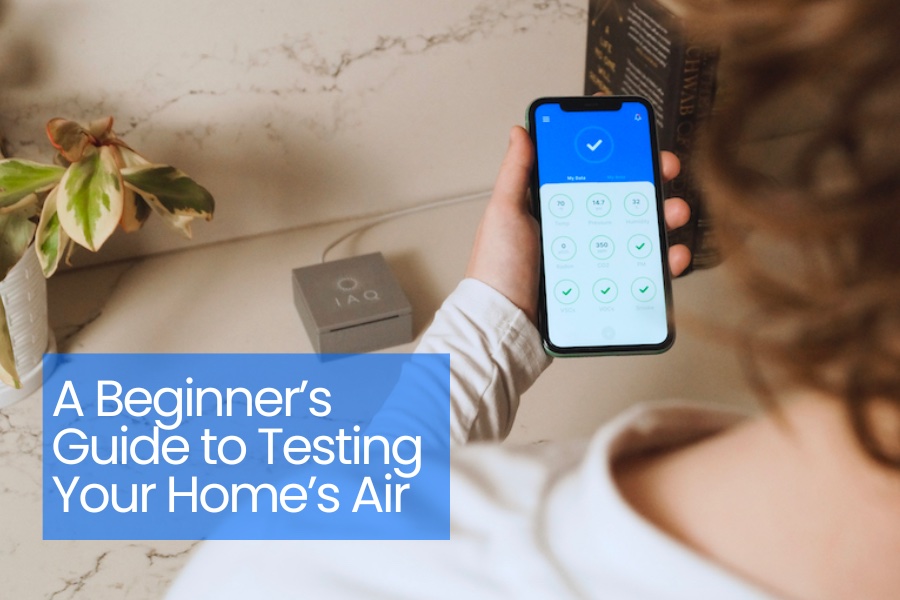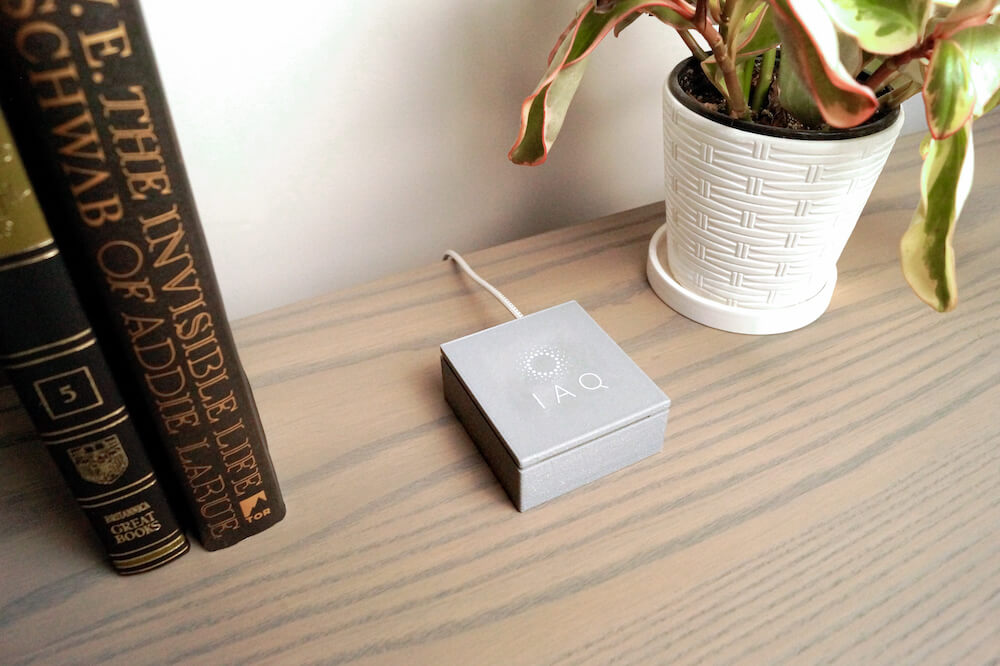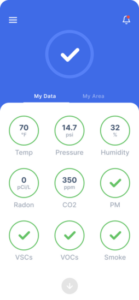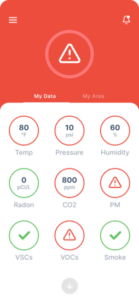
It’s not common knowledge that the air inside your home is more likely to harm your health than the air outside. This is primarily because we spend so much time at home. But it’s also true that indoor air can build up high levels of many dangerous contaminants over time. Unfortunately, most American homes only test for two of them, smoke and carbon monoxide. With the development of new sensor technology, however, it’s easier than ever before to test and monitor your indoor air quality.
This beginner’s guide provides you with all the information you need to know about testing your home’s air and taking steps towards a safe and healthy indoor environment.
What is indoor air quality testing and why is it important to monitor the air in your home?
Defining indoor air quality
Indoor air quality refers to the measurement of what is in the air we breathe inside any building. The relative quantities of various airborne contaminants determine whether or not indoor air quality is safe and healthy.
Importance of monitoring indoor air quality
Your air quality directly affects how you feel, both mentally and physically. Most people know to open the windows or air out their house when they notice an odor, but there are more than 20 components of indoor air quality that can have serious effects on health and well being. Most of these are invisible air pollutants you can only detect with specialized devices like IAQ.
How indoor air quality is monitored
In simplest terms, an air quality checking device monitors pollutants in the air using sensors that estimate size and volume of air particles around it. These devices help ensure you have clean air for better health and comfort. It’s advisable to check your air quality, as the EPA acknowledges that many factors can impact air quality.
What are the different pollutants that contribute to indoor air quality?
Maintaining indoor air quality can be a difficult task. Knowing what pollutants your home holds and how to monitor them can be the difference between living in an unhealthy environment or not.
Common indoor air pollutants
The federal government, via the Environmental Protection Agency, sets standards for six common “criteria air pollutants.” These are ground-level ozone, carbon monoxide, sulfur dioxide, lead, particulate matter and nitrogen dioxide. Each of these pollutants is considered dangerous to human health and can cause damage to property. To address these common indoor air pollutants, homeowners should monitor factors such as cooking fumes, cleaning products, mold, dust, radon, moisture, CO2, Carbon Monoxide (CO), formaldehyde and smoke.
Sources of indoor air pollutants
Indoor air pollutants may come from sources inside your home or the outdoor environment nearby. Common indoor sources include cooking, appliances and electronics, construction materials and biological matter such as mold or rotten food. Common outdoor sources include wildfires, seasonal changes, fuel combustion, and industrial production.

Why is it important to test for multiple factors when monitoring your home’s air quality?
Air quality should be a top priority in any home, since the air you breathe contributes to your wellness in many ways. If you’re concerned about the quality of your household’s air, you need to consider more than just a smoke detector. At any given moment, there are countless chemicals, aerosols and microbes in your indoor air that can lead directly to serious health issues. IAQ recommends monitoring all the criteria air pollutants identified by the Clean Air Act as well as any noticeable dust, fumes, or vapors present in the home.
Health effects of indoor air pollutants
Unhealthy indoor air with heightened or dangerous levels of pollutants can have a broad range of consequences, from minor to serious. At a minimum, low indoor air quality can disrupt your sleep, agitate your allergies, and cause headaches, stress, or difficulty breathing. Prolonged exposure to unhealthy indoor air can lead to serious life-threatening diseases. According to the World Health Organization, indoor air pollution can lead to stroke, heart disease, pulmonary disease, and lung cancer.
How to ensure you’re safe from all indoor air pollutants
Instead of navigating through a complicated system of different monitors for individual chemicals and pollutants, you can now use IAQ to test for more than 20 indoor air quality factors.
What are the best ways to measure indoor air quality?
Overview of different methods for testing IAQ
In the U.S. most households have a smoke detector and a carbon monoxide detector. But new sensor technology has enabled a wide variety of new products on the market that can test indoor air quality. These products range from simple monitors to more technical devices that integrate with a connected ecosystem.
It is also possible to measure air quality using air sampling and laboratory analyses, but these are highly complicated and unnecessary methods for the average household. For many professional and industrial applications, there are also handheld air quality instruments with varying capabilities to monitor air.

What to look for in an air quality monitor
The costs and complexity of measuring your indoor air can add up quickly. Generally speaking, consumers should consider complexity, cost, and how many air components a device can measure.
With most indoor air quality monitors, you can continuously monitor ambient air quality at a relatively affordable cost and without too much technical knowhow. However, the more sophisticated models require significant hardware and software knowledge and experience. In most cases, the more contaminants you want to measure, the more complex and expensive the device.
Additionally, many indoor air quality monitors only pick up a limited set of pollutants. Most require more than one device, stationed at various locations around your home in order to provide full coverage.
Get IAQ: The first device to measure all EPA-identified air pollutants
How can an air quality monitor help you improve the air quality in your home?
When it comes to testing air quality in your home, you want to be proactive about creating a healthy environment. Air quality monitors are an essential tool because they allow you to monitor and check your indoor air quality without having to hire professionals or buy costly equipment. They give you access to data that lets you take action on areas where the air quality might need improvement.
Recommended actions to improve air quality
The most common actions to take to address your indoor air quality include:
- Open windows to let in fresh air
- Circulate air with a fan or air conditioning unit
- Close and seal off doors and windows when outdoor air quality is low
- Use an air purifier to clean indoor air particles
- Clean and disinfect common spaces
- Consider a dehumidifying device
Of course, depending on the data you get from an air quality monitor, you may have to consider more substantial remedial action—for example, in the case of significant levels of mold it will help to contact a specialist. Sometimes, the problem is coming from outside, such as when there are forest fires nearby. In these instances, you’ll want to keep windows and doors closed, keep your house clean, and use fans to circulate air.
Situations when it’s necessary to test IAQ
Most air quality monitors will give a real time reading continuously, so there’s no need to turn them off and on. However, you’ll want to especially consider using a device during a home renovation, if there has been recent damage to the home such as water entry, or if you have family members with respiratory health concerns.



IAQ provides an easy to access data dashboard with tips on how to improve and keep track of the environment’s air conditions.
How does IAQ work, and what benefits does it offer over other air quality testing monitors on the market today?
IAQ measures over 20 different air quality components, making it the most comprehensive monitor on the market. There is no need to integrate with other sensors, and no need for technical expertise to set it up and start gathering data. It requires no installation, no upfront costs, and IAQ easily integrates with any existing smart home technology you have. Once set up, it alerts you on your smartphone or other device when air quality drops.
Indoor air quality is essential for a healthy and safe living environment. While there are many ways to test and monitor your home’s air quality, the simplest solution today is to use an air quality monitor. These devices provide continuous coverage and give you the power to know what’s in the air you’re breathing and take steps to improve it and protect your family from unseen threats.
Sign up to get 30% off and be notified when IAQ launches on Kickstarter







Comments (52)
dr gunter zoloftsays:
February 7, 2024 at 4:37 pmdr gunter zoloft
dr gunter zoloft
flagyl boilssays:
February 8, 2024 at 5:51 amflagyl boils
flagyl boils
cost of cephalexinsays:
February 11, 2024 at 3:07 amcost of cephalexin
cost of cephalexin
cymbalta social anxietysays:
February 11, 2024 at 5:06 pmcymbalta social anxiety
cymbalta social anxiety
how long does it take for lexapro to leave your systemsays:
February 12, 2024 at 10:24 amhow long does it take for lexapro to leave your system
how long does it take for lexapro to leave your system
side affects of escitalopramsays:
February 12, 2024 at 5:22 pmside affects of escitalopram
side affects of escitalopram
azithromycin m/zsays:
February 17, 2024 at 6:42 amazithromycin m/z
azithromycin m/z
can ciprofloxacin treat strep throatsays:
February 28, 2024 at 6:52 amcan ciprofloxacin treat strep throat
can ciprofloxacin treat strep throat
bactrim for pneumoniasays:
February 28, 2024 at 1:01 pmbactrim for pneumonia
bactrim for pneumonia
bactrim genericsays:
February 28, 2024 at 1:10 pmbactrim generic
bactrim generic
augmentin dose for dogssays:
March 22, 2024 at 9:20 amaugmentin dose for dogs
augmentin dose for dogs
contrave schedulesays:
March 22, 2024 at 10:22 amcontrave schedule
contrave schedule
diltiazem cd 120mgsays:
March 22, 2024 at 2:15 pmdiltiazem cd 120mg
diltiazem cd 120mg
flexeril vs somasays:
March 22, 2024 at 7:08 pmflexeril vs soma
flexeril vs soma
diclofenac sodium tabletssays:
March 22, 2024 at 8:46 pmdiclofenac sodium tablets
diclofenac sodium tablets
how long does depakote take to worksays:
March 22, 2024 at 9:21 pmhow long does depakote take to work
how long does depakote take to work
does cozaar cause weight gainsays:
March 22, 2024 at 10:43 pmdoes cozaar cause weight gain
does cozaar cause weight gain
effexor vs lexaprosays:
March 23, 2024 at 2:51 ameffexor vs lexapro
effexor vs lexapro
amitriptyline for migrainessays:
March 24, 2024 at 5:16 pmamitriptyline for migraines
amitriptyline for migraines
what does allopurinol dosays:
March 24, 2024 at 5:26 pmwhat does allopurinol do
what does allopurinol do
aripiprazole nursing implicationssays:
March 24, 2024 at 6:17 pmaripiprazole nursing implications
aripiprazole nursing implications
aspirin ecsays:
March 24, 2024 at 6:59 pmaspirin ec
aspirin ec
celecoxib couponsays:
March 28, 2024 at 12:14 pmcelecoxib coupon
celecoxib coupon
can you take ibuprofen with celebrexsays:
March 28, 2024 at 11:16 pmcan you take ibuprofen with celebrex
can you take ibuprofen with celebrex
does augmentin have penicillin in itsays:
March 29, 2024 at 12:42 amdoes augmentin have penicillin in it
does augmentin have penicillin in it
remeron and pregnancysays:
April 14, 2024 at 6:23 amremeron and pregnancy
remeron and pregnancy
spectrophotometric determination of repaglinidesays:
April 14, 2024 at 8:08 amspectrophotometric determination of repaglinide
spectrophotometric determination of repaglinide
interazioni ezetimibesays:
April 14, 2024 at 10:26 aminterazioni ezetimibe
interazioni ezetimibe
is abilify a controlled substancesays:
April 14, 2024 at 11:21 amis abilify a controlled substance
is abilify a controlled substance
what is protonix 40 mgsays:
April 14, 2024 at 2:21 pmwhat is protonix 40 mg
what is protonix 40 mg
venlafaxine vs lexaprosays:
April 19, 2024 at 12:27 pmvenlafaxine vs lexapro
venlafaxine vs lexapro
what is sitagliptin forsays:
April 19, 2024 at 4:14 pmwhat is sitagliptin for
what is sitagliptin for
actos rabbonisays:
April 19, 2024 at 7:31 pmactos rabboni
actos rabboni
how long does it take robaxin to worksays:
April 19, 2024 at 8:42 pmhow long does it take robaxin to work
how long does it take robaxin to work
is tizanidine a muscle relaxersays:
April 20, 2024 at 2:04 amis tizanidine a muscle relaxer
is tizanidine a muscle relaxer
tolterodine tamsulosinsays:
April 20, 2024 at 2:46 amtolterodine tamsulosin
tolterodine tamsulosin
synthroid thyronormsays:
April 20, 2024 at 8:41 amsynthroid thyronorm
synthroid thyronorm
sildenafil 100mg pricesays:
May 13, 2024 at 9:14 amsildenafil 100mg price
sildenafil 100mg price
how long does sildenafil take to worksays:
May 13, 2024 at 11:52 amhow long does sildenafil take to work
how long does sildenafil take to work
european pharmacy valiumsays:
May 13, 2024 at 12:26 pmeuropean pharmacy valium
european pharmacy valium
cialis online pillssays:
May 13, 2024 at 12:45 pmcialis online pills
cialis online pills
maximum dose of levitrasays:
May 13, 2024 at 12:49 pmmaximum dose of levitra
maximum dose of levitra
diflucan online pharmacysays:
May 13, 2024 at 1:07 pmdiflucan online pharmacy
diflucan online pharmacy
fda warning tadalafilsays:
May 17, 2024 at 8:23 amfda warning tadalafil
fda warning tadalafil
how much is ivermectinsays:
May 18, 2024 at 3:03 amhow much is ivermectin
how much is ivermectin
vardenafil reviewsays:
May 18, 2024 at 9:22 amvardenafil review
vardenafil review
viagra script onlinesays:
May 18, 2024 at 12:53 pmviagra script online
viagra script online
is gabapentin the same as neurontinsays:
June 26, 2024 at 4:14 amis gabapentin the same as neurontin
is gabapentin the same as neurontin
how long does it take for valtrex to worksays:
June 26, 2024 at 7:27 amhow long does it take for valtrex to work
how long does it take for valtrex to work
is cephalexin the same as keflexsays:
June 29, 2024 at 4:38 pmis cephalexin the same as keflex
is cephalexin the same as keflex
provigil post concussion syndromesays:
June 30, 2024 at 2:51 pmprovigil post concussion syndrome
provigil post concussion syndrome
trazodone for dogs 100mgsays:
July 2, 2024 at 3:23 amtrazodone for dogs 100mg
trazodone for dogs 100mg